Eckhard Bick
PORTUGUESE SYNTAX
11. Topic and focus constructions
Running text can be viewed as sentences linked by topic-focus (or thema-rhema) relations. Pragmatically, topic constituents tell us what a statement is about, focus constituents introduce new information, often about the topic. In the examples, topics are underlined, focus constituents are in bold face.
(a) Na beira do rio, dormia um hipopótamo (S).
(b) O hipopótamo estava contente (Cs) e sonhava com uma bela hipopótama.
(c) Hipopótamas eram raras (Cs) na região, mas finalmente tinha encontrado uma.
(d) Era muito bom (Cs) isso.
(e) Ela iria amansar a sua vida e lhe dar filhos fortes (Oacc).
According to Togeby (1993, "Praxt"), focus is the last sentence constituent, that is not definite. Topic material, by contrast, is normally known in advance (from the last sentence, or from extra-lingual context), and will therefore appear in definite form, as names, pronouns or generic terms.
Given the linear nature of language flow, topic constituents are likely to appear left, focus constituents right, as is the case in all examples but (d). In (d), the focus is a subject complement (Cs), as in (b) and (c), and it is located in the usual Cs-position, immediately to the right of the predicator, - so one could say that it's the subject (isso), that is placed in a special way (as opposed to isso era muito bom).
In copula-constructions, subjects are usually definite and topicalized, while the subject complement is indefinite and focused. However, there is no general link between subject and topic, neither for intransitive verbs (a) nor for transitive verbs (f):
(f) A pequena Maria passeava na mata. De repente, um lobo comeu a menina.
Intransitive verbs with agent subjects like dormir or trabalhar, usually place topic subjects to the left (o hipopótamo dormia, 1) and focus subjects to the right (a). Note that the topic subject works fine with only a verb for focus, while the focus subject is not content with a verb as "topic" (2a, 4a-b).
Ergative verbs with patient subjects, like cair or morrer, allow both topic-less focus constituents (2b) and topic subjects (2c) to the right, i.e. after the verb. Focus constituents left of the verb (4), however, without a syntactic topic, sound awkward (though not outright agrammatical) in all cases:
(1a) O pássaro dormia. --- (1b) O pássaro morreu.
(2a) ?Dormia um pássaro. --- (2b) Morreu um pássaro.
(3a) ?Dormia o pássaro. --- (3b) Morreu o pássaro.
(4a) ?Um pássaro dormia. --- (4b) ?Um pássaro morreu.
In order to make possible focus fronting, Portuguese as well as English and Danish uses cleft sentences rather than type (4) sentences:
(4') Era um pássaro que dormia. --- Foi um pássaro que morreu.
In these constructions the focus constituent is moved out of the original clause as a subject complement of a copula verbs (mostly ser), while the original clause seems to become a subordinated subclause, with a relative pronoun as "dummy" for the removed constituent. Syntactically, the finite subclause could either be analysed as an "absolute relative" (a), or as a postnominal adject (DN:fcl) of pássaro (b). The ambiguity seems to enjoy morphological support, since there is a difference in verbal inflection between (a) Fui eu quem o fez and (b) Fui eu que o fiz. In (a), quem governs 3.person singular (fez), suggesting an independent fcl constituent (S:fcl). In (b), que governs 1.person singular (fiz), suggesting closer ties with eu (DN:fcl):
(a)

(b)
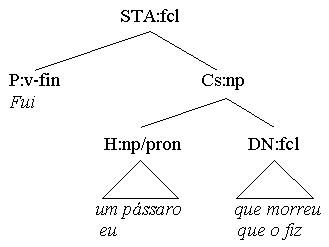
However, neither (a) nor (b) is fully satisfying from a semantic point of view. While the intended meaning is it was a bird that died, analysis (a) literally means something like what died was a bird, while analysis (b) translates as it was a bird which died (rather than another kind of bird). (a) is obviously closer to the intended meaning than (b), but the supposed S:fcl fails the o que/quem-substitution test for "true" absolute relatives:
(O) que morreu foi um pássaro (true absolute relative in S:fcl)
Foi um pássaro (?o) que morreu (different meanings)
Somos nós que/*quem o queremos (agrammatical with quem)
Thus, que in our sentence cannot be replaced by o que like in ordinary subject clauses.
Also, while the relative pronoun analysis works more or less for the focusing of nominal constituents, it seems unsatisfying for pp- or adverbial constituents:

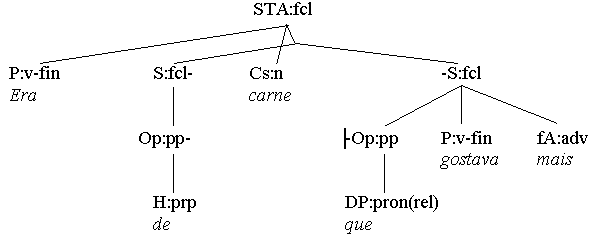
With an adverb in focus
it becomes even more difficult to treat que as a relative pronoun
- we would need to add que to the short and otherwise closed list
of adverbial relative pronouns. More natural seems an analysis of que
as subordinating conjunction (conj-s):
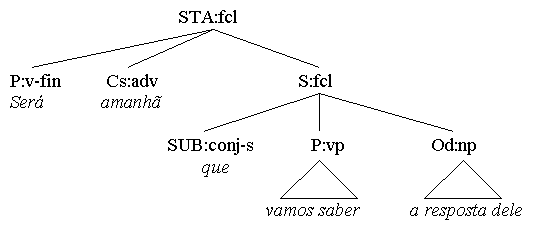
Que vamos saber a resposta dele é certo.
*Que vamos saber a resposta dele é hoje.
A completely different approach to such cleft sentences is a flat analysis where the original constituent functions (from the non-cleft sentence) are maintained, and one regards e/era/foi/será and que as two parts of a syntactic "focus marker bracket" . In Constraint Grammar, this solution is straight forward:

In this notation, we have a focus marker head (@FOC>), with its arrow pointing towards the focused constituent (de carne, hoje), and a focus marker dependent (@FOC<), with its arrow pointing back at the focus marker head.
In a syntactic tree, this would translate into a disjunct focus marker constituent, which could be attached as dependents to the focused constituent as a whole, in the same way in which we have treated "operator adverbs" (não, ainda, até - cp chapter 6):
Gostava não de carne, mas de peixe. Come até rã.
Ainda hoje vamos saber a resposta. Hoje mesmo acabará.
Since the head of the focus marker constituent is a verb, we might regard its form - tentatively - as vp (verb group). Thus, we get:
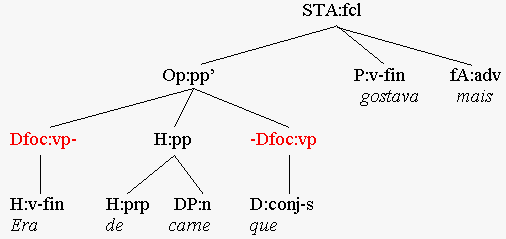
That the focus marker in such sentences is, in fact, a hypotactic group with the 3. person form of ser as its head, is made plausible by the fact that the focus marker head verb can be used on its own, too (without que), especially in colloquial language:
Gosta é
de briga.
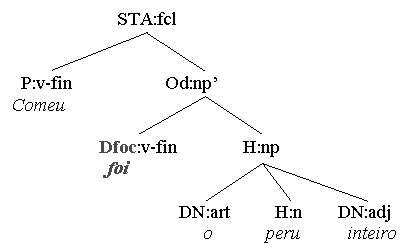
(a') (O que) comeu foi o peru inteiro.
(b) *Que gostava mais, era de carne.
(c) *Que vamos saber a resposta, é hoje.
In a way, que in cleft sentences is a subordinator that does not head a subclause, but merely chains two parts of the same (cleft) main clause. When introducing predicator vp's, we have assigned a similar "chaining function" (SUBaux) to the auxiliary particle que in verb chains after ter :

Here, too, we had the
choice of syntactically showing the subordination - and creating
a unique one-purpose constituent (auxiliary complement, AUX<,?que
comer carne?) in the process -, or else of placing
the subordinator on one syntactic level with the two verbs chained by it,
as in the analysis shown here.
Similarly, we could keep the cleft-sentence constituent que at main
clause level as a focus subordinator, SUBfoc:
In this analysis, we
avoid the awkward stranding of a conjunction as rightmost part of a disjunct
dependent, while still marking both focus scope (the head of Dfoc Era)
and cleft position (SUBfoc que).
We have seen that the
"natural" order of topic and focus is left-to-right, and that a focus constituent
can be marked by fronting and/or clefting. Subject topics are usually fronted
and thus marked anyway, but non-subject topic constituents can be marked
by fronting, too:
Para o vizinho,
vendeu o seu carro.
(T2) A princesa,
sonhava com ela cada noite.
*Com a princesa,
sonhava com ela cada noite.
(T3) À filha,
prometeu-lhe um cavalo.
*À filha, prometeu
a ela um cavalo.
Aos inimigos, matou-os
todos.
A dinheirama, ganhou-a
no jogo do bicho. (T2) is quite different,
since the topicalized constituent, com a princesa, still has a -
pronominal - place-holder in its old position (com ela). Also, the
topicalized constituent (unlike T1), is "normalized" to nominative case
(a princesa, not com a princesa), i.e. normalized to subject
case. Mateus et. al. (1989, "Gramática de Língua Portuguesa")
call this construction for pending topic ("Deslocação
à Esquerda de Tópico Pendente"). Pending topics with other
than "nominative" case (T3) are only grammatical with enclitic placeholders
(-lhe, but not a ela, -os but not os inimigos).
While (T1) allows a
straightforward syntactic analysis - (Oacc P Opiv) or (Opiv P Oacc) -,
pending topics do not. In (T2), there is in the topic constituent a clash
between form and function ("nominative" np vs. Opiv), and (T3) looks like
a violation of the uniqueness principle.
Since we don't want
2 Opiv's anyway, a solution for the "nominative" topic in (T2) could be
to view it as a free topic predicative of the place-holder Opiv:
In (T3), the breach
of the uniqueness principle can be cushioned somewhat by analysing pending
topic objects as free objects (fO) , i.e. as not valency
bound. Also, the syntactic distinction between enclitic Odat
and non-pronominal Opiv helps defend the uniqueness principle in
the dative case:
APPENDIKS 1:
Word classes (morphological
form)
When discussing syntax,
one does not usually pay much attention to the smallest building blocks
of syntactic form, words. Word boundaries are viewed as stable and self-evident,
with blank spaces being all that's needed to determine what a word is.
Consider:
(2) dá-me-lo
(3) dar-me-iam
(4) O Porto, Estados
Unidos
(5) do que (than),
mesmo que (though)
(6) em vez de
(7) de maneira que
(8) fato de banho
A glance at a list
of Portuguese conjunctions reveals a majority of complex words like (5)
and (7), that in theory would allow further syntactic analysis, but usually
are regarded as smallest units of syntactic form. For complex prepositions
(6) , the internal form of such units is typically that of adv+prp,
or prp+np+prp, with the last preposition valency governing the complex
preposition's argument.
Often, words are not
assigned a form category at all, and word class is derived from
syntactic function - as when calling como for all of adverb, conjunction
and preposition, depending on its being used as adverbial, fcl-subordinator
or acl-subordinator ("pp"). Similarly, adjectives are often assigned noun class when functioning as (head of) subject or object (um dinamarquês),
and nouns are tagged adjectives, when they appear postnominally (um político
pacifísta).
In this approach, Portuguese
word classes will be regarded as form categories and defined primarily
by morphological criteria, in particular by inflexion category inventory.
Thus, nouns, proper nouns, adjectives and (cardinal) numerals feature number
and gender, but while both these categories are word form categories
for adjectives (i.e., freely inflecting for the individual word),
only number is "free" in nouns, whereas gender is a lexeme category
to be derived directly from the lexicon, i.e. fixed for the individual
word. For numerals, the inverse is true: gender is a word form category
(duas), while number is a lexeme category, i.e. fixed - as might be expected
for semantic reasons ... In the case of proper nouns, finally, both
gender and number are lexeme categories.
Pronouns can
be subdivided morphologically by the same criteria: determiner pronouns
(pron-det: estas, seus, cuja) inflect like adjectives, while independent
pronouns (pron-indp: nada) inflect like proper nouns, i.e. they don't.
Personal pronouns are morphologically special in that they also
inflect for person and case. Articles should, along this line of
reasoning, form part of the determiner pronoun class, but will be distinguished
for reasons of grammatical tradition.
Finite verbs
are easily defined morphologically due to their characteristic combination
of inflection categories (person, number, tense, mode). From this perspective,
it is the finite verbs that are the "true" verbs, while the non-finite
verbal subcategories could logically be subdivided as "substantival" infinitives
(inflecting for number and person, but not gender), "adjectival" participles
(word form inflecting for both number and gender) and, finally, "adverbial"
gerunds (without gender or number).
For adverbs
(with the exception of -mente-adverbs), prepositions, conjunctions
and interjections, morphological word class criteria are difficult
or impossible to establish - barring closed word lists, and they might
therefore be lumped together in one "particle" class. However, as a tribute
to grammatical compatibility with other systems of analysis, the traditional
categories (and syntactic definitions) have been maintained for these cases.
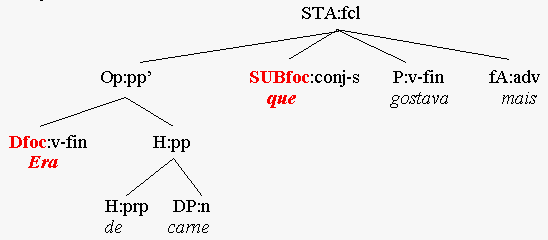

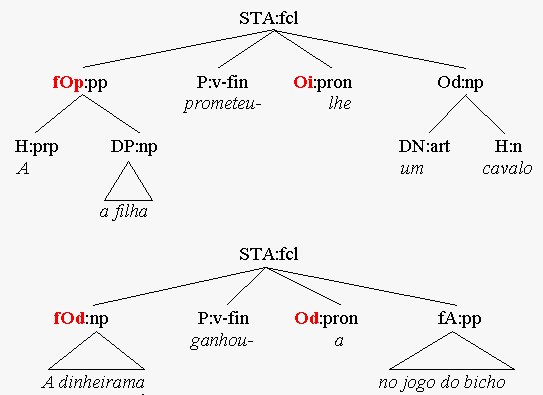
symbol
category
examples
n
noun
nome
substantiv (nomen)
árvores
n(F P)
um oitavo
n(<num> M S)
prop
proper noun
nome próprio
proprium (egenavn)
Estados=Unidos
prop(M P)
Dinamarca
prop(F S)
adj
adjective
adjetivo
adjektiv
belas
adj(F P)
terceiros adj(<num>
M P)
num
numeral
numeral
numeralia
duas
num(F P)
17 num(<cif>
M P)
v
v-fin
finite verb
verbo finito
finit verbum
(bøjet i tid)
fizessem
v-fin(IMPF 3P SUBJ)
v-inf
infinitive
infinitivo
infinitiv
fazermos
v-inf(1P)
v-pcp
participle
particípio
participium
comprados
v-pcp(M P) [attributive]
tem comprado
v-pcp [verbal]
v-ger
gerund
gerúndio
gerundium
correndo v-ger
art
article
artigo
artikel
os
membros art(<artd> M P) [definite]
uma criança
art(<arti> F S) [indefinite]
pron
pron-pers
personal
pronoun
pronome pessoal
personligt pronomen
mim
pron-pers(1S PIV)
tu pron-pers(2S
NOM)
pron-det
determiner
pronoun
pronome determinativo
determinativt pronomen
(adjektivisk pronomen)
estas
pron-det(<dem> F P) [demonstrative]
muita
pron-det(<quant> F S) [indefinite]
cujos
pron-det(<rel> M P) [relative]
quantos pron-det(<interr>
M P) [interrogative]
minhas pron-det(<poss
1P> F P) [possessive]
pron-indp
independent
pronoun
pronome independente
independent pronomen
(substantivisk pronomen)
isto
pron-indp(<dem> M S) [demonstrative]
algo, nada
pron-indp(<quant> M S) [indefinite]
os=quais
pron-indp(<rel> M P) [relative]
quem
pron-indp(<interr> M S) [interrogative]
adv
adverb
advérbio
adverbium
facilmente,
devagar adv [modals]
aqui,
lá adv [pronominals]
muito,
imensamente adv [intensifiers]
onde,
quando, como
adv [relatives or interrogatives]
não,
até, já
adv [operators]
prp
presposition
preposição
preposition
contra
prp
em=vez=de prp
<c>
in
interjection
interjeição
interjektion
oi!
in
conj
conj-s
subordinating
conjunction
conjunção subordinativa
underordnende konjunktion
que
conj-s
embora
conj-s
conj-c
coordinating
conjunction
conjunção coordenativa
sideordnende konjunktion
e conj-c
ou conj-c
pu
punctuation
pontuação
tegnsætningstegn
,
pu [komma]